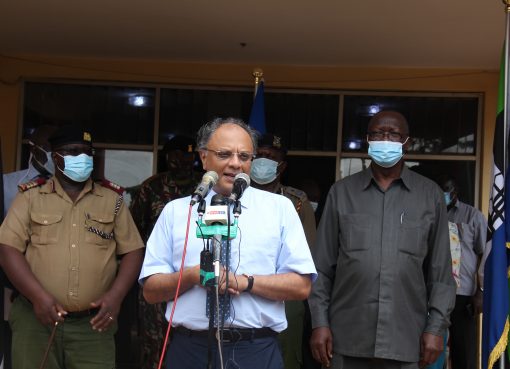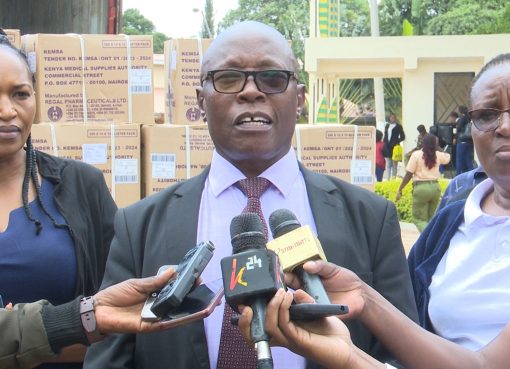The national government has identified food security as one of the four key areas that the nation will focus on in the next five years even as the president seeks to cement his legacy.
The other pillars are manufacturing to create employment for the youth, housing and universal healthcare.
To achieve food security and ensure not a single Kenyan dies of hunger, the government has also changed tact from providing food rations to investing in irrigation which is a more viable and sustainable option.
Turkana County is one of the counties that have been affected by food insecurity for many years. The county receives less than 250mm of rain annually in turn making the locals food insecure.
County executive committee member for agriculture, pastoral economy and fisheries Chris Aletia said food insecurity is one of the key pillars the county government of Governor Josphat Nanok will prioritize in his second term.
Aletia says before county governments came into place in 2013, locals were used to food rations, sight of animals dying due to drought of and a cycle of conflicts over pastures and water were the order of the day.
“There were only less than 10,000 acres of land under irrigation but the story has changed. The county government has increased land under irrigation to 40,000 acres and introduced cultivation of high traditional value crops,” says Aletia.
Locals have been trained in Israel and Ethiopia on dry land agriculture. Irrigation schemes have been expanded from 30 to 56 spread across the county.
In addition, other ministries like that of Natural Resources have kicked off the process of distributing 3,000 fruit trees to institutions and selling to individuals to boost food security and improve the forest cover.
One of the success stories in terms of irrigation is Moruese Irrigation Scheme at the foot of Moruese Hills in Loima Sub County.
The scheme is a small green paradise in the middle of a simmering wilderness with lush maize farms. Something good is coming out of the sun-baked sandy soils.
The 600-acre irrigation scheme draws its water from River Turkwel. The water is guided in canals from the river to the farms that directly feed 600 families, and thousands of residents in surrounding communities.
In the scheme, the farms are bursting with a variety of crops including beans, maize, sorghum, green grams, millet, vegetables, bananas, watermelon and tomatoes, all of which seem to defy the searing heat around them.
The scheme started in 1978, initially as a rain-fed farming project. In 2014, the county government with the support of the World Food Programme (WFP) and a host of other donors revived the scheme and the fortunes of 600 families behind it.
They improved the canals and increased the water volume, provided the farmers with certified seeds of different crops and training. They also supported the farmers to plant them and water scarcity was no longer an issue.
Each family runs a one-acre farm with two or three planting seasons per year, depending on the crop.
Speaking in Moruese in Loima Sub County during the ground breaking ceremony for expansion of a 600 acre irrigation scheme, former Deputy Governor Peter Ekai hailed the cooperation of NGOs and government to improve the livelihoods of the locals at the same time blaming lack of coordination for the then sad state of affairs.
“It is time for organizations working in this county to begin cooperating amongst themselves instead of each organization doing their own separate projects,” says Ekai. He said cooperation will yield better results as compared to the current situation where most organizations work independently.
“As a county, our priority is to ensure that we reduce poverty among the county residents,” said Ekai.
Speaking at the same event, USAID director of mission Ms. Karen Freeman said the agency is shifting its focus from humanitarian assistance to development initiatives.
Freeman said, “A combination of humanitarian assistance and development will help boost the resilience of communities instead of just depending on humanitarian assistance.”
The decision was reached at after a careful examination of the USAID interventions during the 2011 drought in the country where billions of Shillings were spent on humanitarian assistance.
Currently USAID invests more than Sh 35 billion to support communities and their livelihoods in nine arid and semi arid counties in Kenya.
Freeman said the 600 acres irrigation scheme will help more than 580 households produce crops continuously throughout the year. USAID has helped the community establish a water use management committee that will be responsible for the day to day management of the irrigation scheme.
As a testament to the success of the scheme, plans are underway to expand the scheme from the current 600 acres to 3,000 acres in order to serve more people.
The county is considering cementing of the canals to ensure that not a single drop of water is lost to the dry sandy soils around them on its way to farms. This, and more training for the farmers will expand the little green paradise in the middle of Turkana.
There is huge potential in the region and the local farmers need more training because historically, Turkana people have been pastoralists not farmers.
The discovery of water aquifers at Lotikipi and Napuu are a major boost for the food security efforts in the county. Two aquifers were discovered at Napuu, Lodwar and Lotikipi with capacities of 10 and 200 billion cubic metres respectively.
County Chief Officer for Water Moses Natome says if tapped properly, it will be a major boost to water and food security in the county. Currently, debate still rages over the salinity of the water at Lotikipi.
Unlike, the Lotikipi aquifer, the Napuu aquifer is proving to be a success story so far. The water from the aquifer is fresh and is currently being used for irrigation of farms.
The chief officer says the county, with support from Kerio Valley Development Authority have sunk five boreholes which are being used for irrigation.
He adds that plans are underway to set up tanks and pipe water to nearby villages including Narewa, Cannan IDP camp and Turkana university college.
“In addition, the growing demand for water caused the population influx in Lodwar and several construction projects,” Natome says.
At Nakwamekwi, one of most populous villages in the town, a contract has been awarded for the piping of water to the village. He warned that action would be taken if the contractor does not complete the works as agreed. Currently, there are 1267 boreholes and 1,000 shallow wells in the county.
A total of Sh 600 million has been set aside this financial year for water services among them water infrastructure, and drilling of 14 water pans two per Sub-County.
These funds are not enough because the sector needs Sh. two billion as indicated in the County Integrated Development Plan. Consequently, the department hopes that partners would help fill the gap.
The main challenge facing the water sector in the county includes water spillage and lack of accountability in the revenue collected from water bills. To address, these challenges, Natome says the county government has rolled out a pilot project for water ATMs in Lodwar to promote accountability.
“The water ATMs will help increase accountability and revenue collection,” says Natome.
If implemented, these projects can end the water scarcity in the county, whose main population depends on pastoralism as their main source of livelihood.
With these interventions from the government and other development partners, the future for the county in matters food security can only be bright.
By Peter Gitonga



